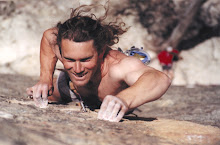I come from a climbing background. Without going into too much detail for non climbers, adventure and multi-pitch climbs have several ratings, but essentially these are comprised of difficulty, duration and risk.
So .... I've conceived a grading system for adventure rides, but welcome people's input. Please note this discussion point is only in reference to solo and unsuported rides, and does not include road rides. After all, road rides are much like "sport climbing", so the risk isn't really there. Also, I know some people do incredibly long 3 year rides etc, but at least in my eyes, they must be receiving support en-route even if this is solely in the form of purchases from shops or from locals. Food and water sourced en-route i.e. stealing a fish from the claws of a brown bear can still count as unsupported. Similar, less risky past-times like catching your own fish can also count:)
So, my disclaimer.... As for climbing, any two people doing exactly the same task may perceive it differently because of all manor of factors inc. physiological and psychological, equipment, preparation, navigation ability, local weather factors (wind, fire, rain, floods, snow (not for my ride)), and so many more.
So my conceived scale is as follows:
Unsupported Duration: i.e. a leg of a ride between two resupply points
Grade 1 <= 5 days
Grade 2 >5 days & =<8 days
Grade 3 >8 days & =<13 days
Grade 4 >2 weeks & =<3 weeks
Grade 5 >3 weeks & =<4 weeks
Grade 6 >4 weeks & =<6 weeks
Grade 7 >6 weeks
Difficulty/Risk:
This is based on perceived exertion averaged out over the duration of the leg, but also considers inconsistency and difficulty of terrain covered, and associated risk should the shit hit the fan. Risk is largely associated to proximity to outside assistance, water, food, and shelter. Even though targetted for an individual (because this is the highest risk), the risk can possibly be reduced if two or more riders split the spares and tools they are carrying. Please also consider that groups splitting up for whatever reason can present its own risks, especially if there is no means of, or inadequate communication.
Grade A: Conventional MTB tyres will suffice, but depending on terrain, thorn protection may be required. Expect unsealed roads, decent road signage, reliable water available at regular intervals, high potential for assistance from a passersby! NB potential for external assistance will vary from season to season, and also around school holidays etc. If you ride in a place outside of the "preferred season", then YOU evaluate YOUR OWN RISK.

Grade B: Same as above, but expect more soft and sandy patches, bigger and more sustained corrugations and big stones. Water may also be more scarce.

Grade C: 4" tyres are recommended, but you could get by without if you are accepting of some/lots walking, and preferably travelling light. If heavily loaded, 4" tyres are of significant benefit, and could be the difference between succeeding or not. Likelihood of bike failure is definitely reduced with 4" tyres. Expect more corrugations and big stones. Nearest external support or water source is potentially 2-3 days away.

Grade D: Mandatory 4" tyres (to actually ride). Pannier system should be extremely sturdy, maybe also "expedition" volume. A trailer is most likely also required for some water/equipment transport. Expect long and sustained travel in soft and technical terrain, creek crossings w/o bridges, sustained climbing/descents of mountains or dunes, little signage so capable of navigation, nearest potential external assistance 1 week or more away (other than by sat-phone), by bike.


Grade E: Even tougher terrain again. May require expedition "sausage bag" on top of conventional panniers for carrying capacity. Alternatley, the rider may be riding extremely light (in semi-supported nature) since riding any "heavier" is on the verge of capabilities of even a 4" bike. The central Simpson desert and snow conditions for the Alaska Ultrasport are two examples.

Grade F: I have reserved this grade for territory not even ridable on 4" tyres, most likely requiring unique or modified bike design. Simpson desert off-track and up steep side of the dunes is one example that comes to mind;)

A "+" or "-" denotation can also be included to help differentiate grades.
So, with the above in mind I have regraded each leg of my 10 Deserts ride:
Leg 1. Tanami track: 2C-
Leg 2. CSR: 5D+
Leg 3. Road: no rating
Leg 4. Anne Beadell: 4D-
Leg 5. Oodnadatta track: 1A
Leg 6. Strzelecki track: 1B-
Leg 7. Walkers Crossing / Old Birdsville track: 1B
Leg 8. Simpson Desert (French Line - east to west): 2E
Leg 9. Old Andado Track: 1B+
I believe the Alaska Ultrasport 1100mi race from Anchorage to Nome is another great bike ride that will have to be graded on this scale. I'll be doing this in 2011, so I will let you know how this compares.
Well I hope this is of some help for anyone else's plans.





1 comment:
Thanks for that Russ, good idea to give us an indication on jsut how tough your trip was. Spill the beans, what are you doing next?
Post a Comment